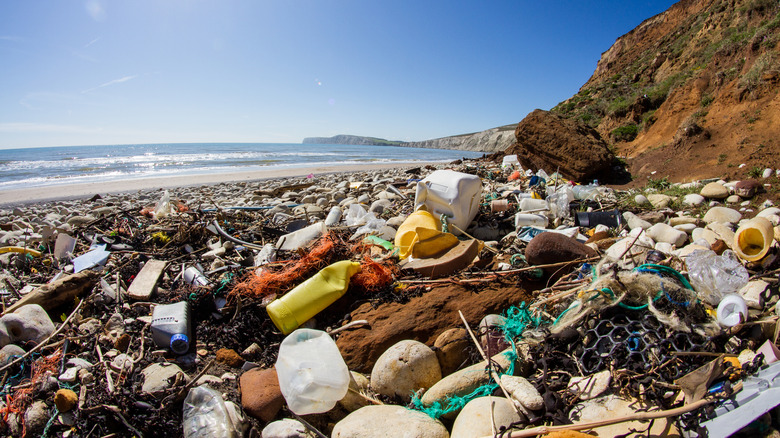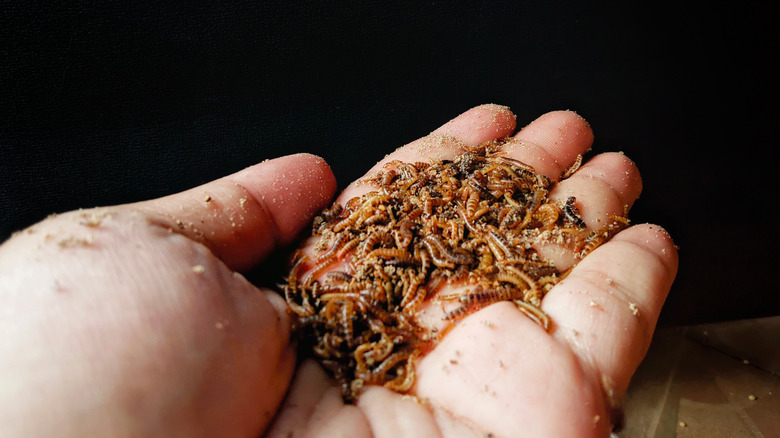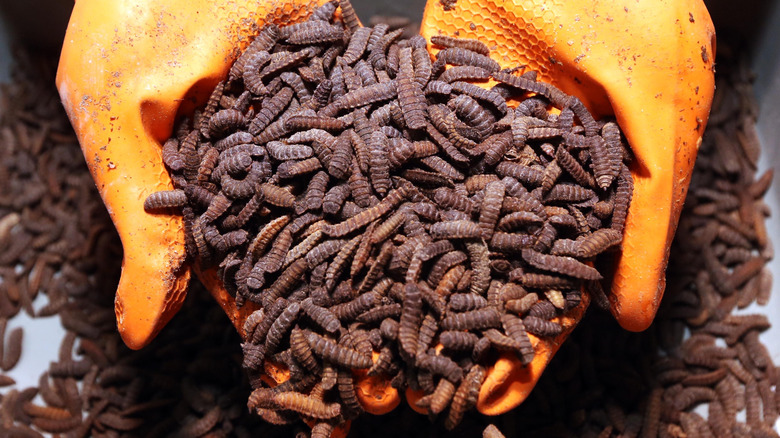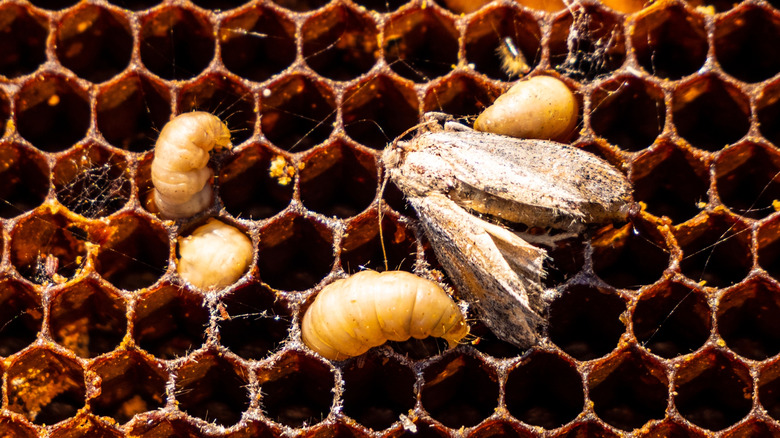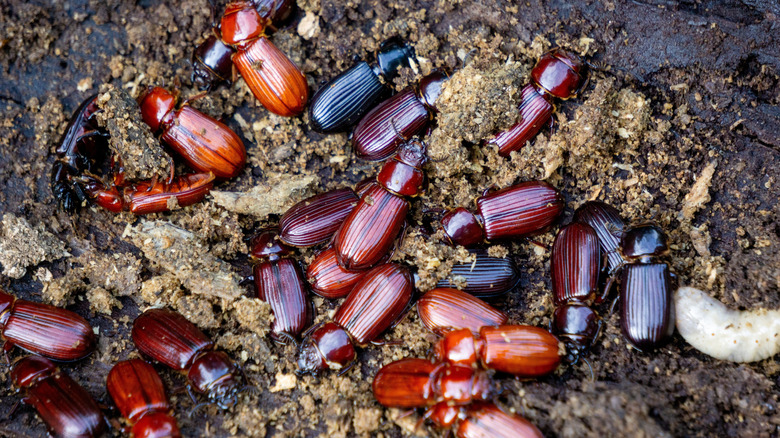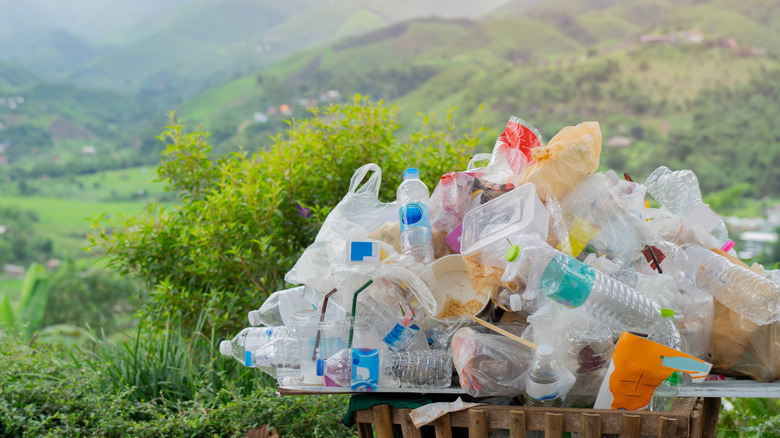4 Insects That Can Actually Eat Plastic
Humanity's impact on the environment during our short history on the planet has been profound. Global temperatures are on the rise, species are going extinct at an unsettling rate, and strange phenomena — like researchers starting to see green beneath the Arctic ice and flowers blooming in Antarctica — are becoming commonplace.
Plastic pollution, however, has become one of the defining environmental crises of our time. From the 1950s to 2019, plastic production on our planet increased 230-fold. A significant amount of that production finds its way into the environment. Each year, the United States alone produces 37.83 million metric tons of plastic waste. Startups and environmental groups like The Ocean Cleanup are doing their part to curb the amount of plastic waste that irrevocably enters our ecosystems and food chains, but they can only do so much. That's why much has been made of the discovery of various animal species that can consume and break down plastics naturally in recent years, presenting humanity with another potential tool to tackle this growing environmental issue.
Researchers in Kenya have recently discovered a species of mealworm larvae that can break down polystyrene, one of the most stubborn types of plastics to biodegrade. These insects, known scientifically as Alphitobius diaperinus, not only consume the material but appear to process it in a way that could someday help researchers bring effective plastics biodegradation to scale. But surprisingly, the mealworm is just one of several species of insects that scientists are shining an increasingly bright light on to highlight how they could help us dig — or eat — our way out of the plastic conundrum we've put ourselves in.
How African mealworms devour plastic
Published in September 2024 in Scientific Reports, a recent study revealed that mealworm larvae in Kenya can consume polystyrene, the key component in Styrofoam cups and packaging material, without suffering significant harm. The researchers fed different groups of the larvae three separate diets for more than a month: one exclusively of polystyrene, one of bran, and one of a plastic-bran blend. Those that ate the blend were able to break down larger amounts of the plastic and survived in greater numbers, showing that a varied diet is needed for them to be effective.
Tellingly, the mealworms that ate only plastic were able to survive, but they were less effective at breaking the plastic down. This indicated the importance of the larvae's gut biome in the process. Specialized bacteria in mealworm's digestive system, including Proteobacteria and Firmicutes, can adapt to changing environments and are able to break down a variety of complex substances. Specifically, Kluyvera, Klebsiella, and Citrobacter, genera of bacteria known for their ability to produce enzymes that can digest synthetic plastics, were also common in the insect's digestive tract.
The presence of these bacteria indicates that the mealworms themselves aren't the ones doing the heavy lifting to break down the polystyrene, but rather the ability of its gut biome to adapt to changing substances, including plastics, is responsible for the remarkable phenomenon. Isolating these bacteria and the enzymes they produce, the study's authors claim, could be the key to creating microbial solutions capable of tackling the plastic problem at scale someday.
Black Soldier Flies have entered the chat
Black soldier fly larvae, an insect already famed for its ability to bioconvert a range of organic waste, might hold new promise in tackling the plastic problem. A recent study published in the journal Microbiome has revealed that the larvae, while not able to directly consume plastic, have the potential to serve as "bioincubators" that can isolate key microbial strains and enzymes to assist plastic biodegradation efforts in the future. The role of such synthetic biology — using biotech methodologies to engineer new chemical systems with a certain goal in mind — could be crucial to effectively combating the world's plastic crisis.
In the study, the research team reared populations of the larvae on polyethylene and polystyrene diets, which increased the amount of Actinobacteria in the insect's gut biome. This bacteria phylum is known for its ability to degrade plastic. Just as importantly, the alkane hydroxylase and monooxygenase genes — the enzymes responsible for breaking down the saturated hydrocarbons found in plastics — were noticeably enriched in the groups that fed on the plastics.
This research lends further support to the fact that oxidation, the chemical reaction between oxygen and polymers in plastics, is vital to the initial steps of effective plastic degradation. It also underscores an exciting shift: rather than relying solely on an insect's natural consumption capabilities, scientists are starting to look closer at leveraging their microbial environment to pioneer new methods for addressing the world's mountains of plastic waste.
Wax Moth spit could do the trick
Wax worms are the caterpillar form of several wax moth species. Only a few millimeters (0.1 inches) long at birth, they grow to roughly three centimeters (just over an inch) before they move onto their next life cycle stage. The worms have a habit of feeding on beeswax, but they also have the ability to degrade polyethylene, one of the most commonly used plastics there is.
A study published in Nature Communications in 2022 reveals that the wax worm's secret lies in its saliva. Researchers identified two enzymes in the worm's spit capable of breaking down polyethylene at room temperature. Encouragingly, the enzymes go to work in mere hours, a stark contrast to the centuries it typically takes for plastic to degrade on its own.
Scientists are unsure why the worm's saliva contains the enzymes needed to do this, but they suspect that the enzymes evolved to help the worms digest beeswax. They were also able to produce pure solutions of the proteins found in the wax worm saliva, which were effective at breaking down the plastics they were tested on. If brought to scale, the insect's saliva could be used as a first step in degrading plastic waste, which could then be further broken down by a range of microbes found in the gut microbiomes of other insects like mealworm and black soldier fly larvae.
Darkling beetles to the rescue
Darkling beetles, particularly from the Tenebrionidae family, are another cast member in the plastic degradation play, and — surprise — it's their larvae that are the true heroes. In 2020, researchers published a study in Applied and Environmental Biology about Plesiophthalmus davidis, a species of darkling beetle indigenous to East Asia. The beetle's larval form was able to survive strictly on polystyrene foam for 14 days.
In a recurring theme, the larvae's gut biome was responsible for this ability. The researchers found that bacteria from the genus Serratia increased sixfold during the time the larvae fed on the Styrofoam. In contrast to the diverse types of bacteria found in the gut biomes of other larvae with similar abilities, only six different bacteria species were present in the biome of this particular insect species.
The research constituted a discovery of yet another insect and bacterial strain capable of plastic degradation that scientists might someday be able to utilize in waste management strategies and solutions.
The future of insects and plastic degradation
Insects and their microbiomes are increasingly emerging as unlikely but essential allies in the fight against plastic pollution. A comprehensive review of the scientific literature highlights that numerous insect species, particularly larvae, harbor digestive systems with enzymatic abilities to break down plastics.
However, scientists have also noted that the promise of these insects and their bacterial companions has yet to result in any significant strides toward helping the world's plastic waste crisis. And while researchers emphasize the need to integrate such natural capabilities into industrial-scale solutions through synthetic biology and microbial engineering, complementing existing recycling methods in the process, that reality remains a distant dream.
The more we learn about these insect species, the more we are reminded of the critical importance of biodiversity in addressing global challenges, which is just one of the reasons scientists are striving to bring animals like the Tasmanian tiger back from extinction and otherwise do everything possible to restore a broken natural world. As research continues, the small, crawling creatures that are considered pests in many parts of the world might just hold the key to a more sustainable future.
